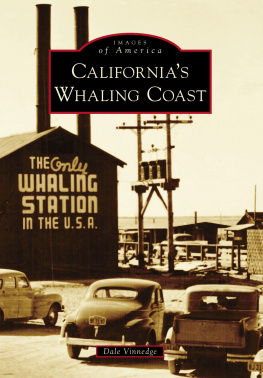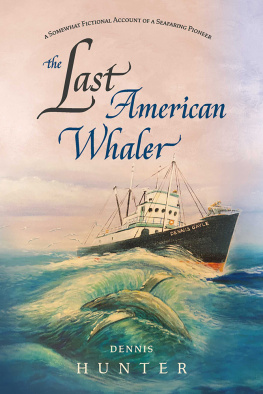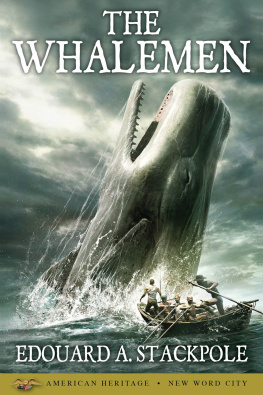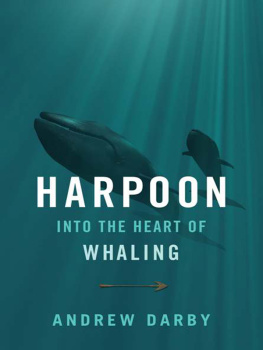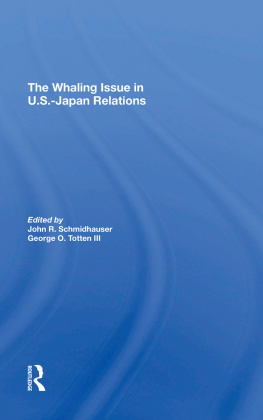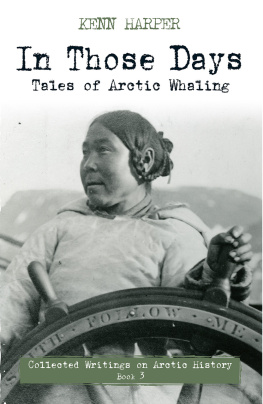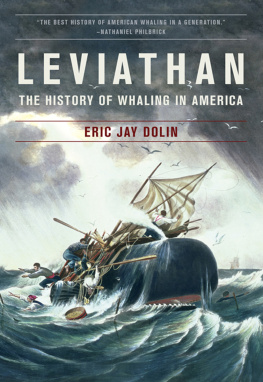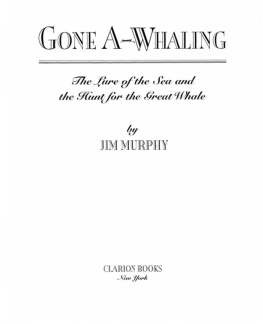ACKNOWLEDGMENTS
The author wishes to acknowledge a few of the sources whose collections formed a large part of this book. The San Francisco Maritime Museum Library was a valuable source, in particular accessibility to the Alta California Newspaper collection, covering the 1850s to the 1890s. The Oakland Public Library and access to the Oakland Tribune provided information on whaling from the 1800s and 1900s. The San Francisco Public Library and its San Francisco Chronicle collection provided important information. Also, collections of newspapers all over the state on microfilm form a part of the book. Information for parts of the book was available thanks to the public libraries of Santa Cruz, Monterey, San Diego, Watsonville, Salinas, and many others. Universities, including Humboldt State, San Jose State University, and the University of California, Berkeley are reflected in the material. Also included in the list are the archives of the State of California, San Francisco Maritime Museum, and the Kendall Whaling Museum, now part of the New Bedford Whaling Museum.
The photographs are all part of the collection of the author. Many of the photographs were purchased through postcard bourses. However, the bulk of the photographs and postcard images have been collected through online auction houses that have started up in the last 10 years. Never could all of this material have been collected through used-book stores and antique shops.
Books form a very small part of this work, because few volumes have been written on the subject of California whaling after 1900. There have been a number of magazine articles that contributed to various areas of whaling over the years. A few of these books and magazines are mentioned in the bibliography.
DISCOVER THOUSANDS OF LOCAL HISTORY BOOKS
FEATURING MILLIONS OF VINTAGE IMAGES
Arcadia Publishing, the leading local history publisher in the United States, is committed to making history accessible and meaningful through publishing books that celebrate and preserve the heritage of Americas people and places.
Find more books like this at
www.arcadiapublishing.com
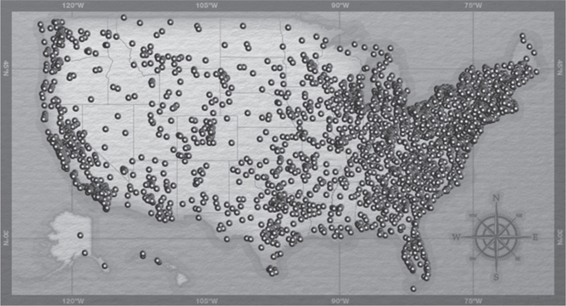
Search for your hometown history, your old stomping grounds, and even your favorite sports team.
BIBLIOGRAPHY
Berwick, Edward. Offshore Whaling in the Bay of Monterey. The Cosmopolitan. October 1900: 631.
Bertao, David E. The Portuguese Shore Whalers of California, 18541904. San Jose, CA: Portuguese Heritage Publications of California, 2006.
chartsmapsgraphics.com
Daily Review (Hayward, CA). January 10, 1957.
Dolin, Eric Jay. Leviathan: The History of Whaling in America. New York: W.W. Norton, 2008.
Eureka Humboldt Standard. June 3, 1960.
Independent (Pasadena, CA). November 17, 1971.
Long Beach Press. November 17, 1910.
Nevada State Journal. May 16, 1919.
Pacific Fisherman magazine, January 1914, October 1926, and July, October 1949.
Scammon, Charles Melville. The Marine Mammals of the North-Western Coast of North America: Together with an Account of the American Whale Fishery. 1874.
Walsh, Lt. Q.R. Whaling Industry in Australian and Antarctic Waters, by United States Coast Guard, Inspector of Whaling.
Webb, Bob. On the Northwest, Commercial Whaling in the Pacific Northwest 17901967. Vancouver: University of British Columbia Press, 1988.
www.canneryrow.com
www.caviews.com
www.cthistoryonline.org
www.library.csustan.edu
www.mysticseaport.org
www.skinnerinc.com
One
YANKEE WHALING
In the early days of the nations history, New Bedford and Nantucket took the lead in the hunt for the whale. Ships roamed the seas of the world, hunting whales for their oil and bone. From the Arctic to the South Seas and into the South Pole, the whalers gained a complete knowledge of the great oceans. For more than a century, American seamen dominated the whale oil industry.
When attention was directed toward California, the whaleships of New England were among the first to arrive. They were not interested in hides and tallow, however. It was learned that valuable sea otter skins could be obtained there, skins that in China would bring high prices. Whaling was temporarily discontinued while the captains became fur traders. The Spanish, and later Mexican officials, prohibited this trade, but the Yankee captains found ways of circumventing the laws and had a thriving trade in collecting furs. This trade, however, soon attracted Boston ships, which were laden with trade goods, forcing the whalers to return to their craft.
Scammons Lagoon, on the coast of Lower California, bears the name of Charles Melville Scammon, one of the more famous of the whalers operating in West Coast waters. He was known to set out from San Francisco and return with a full cargo of oil after only a short few months. His ship was not weather-beaten, as were ships that had been out from two to five years to fill their holds. Old whalers knew that Captain Scammon had discovered a spot where whales were plentiful and easy to get. How easy they never suspected.
The truth was that Captain Scammon learned that the gray whales lay hidden in shallow lagoons, along the coast of Baja California Del Sur, where the females gave birth to their young. One of these places was a large landlocked bay resembling San Francisco Bay, but smaller. Scammon would sail his ship into the bay and set up his try-works on shore. His men would then go after the whales from the smaller whaling boats in the landlocked harbor. It was not long before there was company in the lagoon, and the whalers spread out from Scammons Lagoon all the way south to Magdelena Bay. The first arrivals to the lagoons found a huge pile of discarded bones that had no commercial value. Captain Scammon did well financially, and the lagoon still bears his name.
New Bedford being far away from the whales, and with greater railroad access after 1869, ship owners decided to make San Francisco their whaling base. The business grew to tremendous proportions, and even New Bedford and Nantucket were eclipsed as operating centers. Along with San Francisco, a fleet went out of Honolulu, operating under the flag of the Kingdom of Hawaii. During the off-season, the old San Francisco whaleships would anchor in Oakland Creek, as the estuary was then called.
Several great disasters struck the whaling fleet, which was on the verge of collapse. The first of these disasters occurred in September 1862, when 33 ships of the San Francisco and Hawaiian fleet got trapped in the ice in the Bering Sea and were crushed into matchwood by the quickly advancing freeze. Leading up to the disaster, the season had been a good one, and the whalers were unusually plentiful in the far north. The whaling fleet worked its way into the North Pacific and began moving slowly back as the season advanced. The weather turned cold, and the ice and a cold snap came ahead of its usual time. The ice closed in so quickly on the doomed ships that they did not have a chance to escape. They were completely crushed and lost, along with their valuable cargoes of oil and bone.
The men managed to make their way over the ice and along the shore to three of the ships that had taken up anchorage beyond the islands and out of the ice danger. These craft, greatly overloaded, bore the survivors back to the Hawaiian Islands. San Francisco was especially hard hit by this disaster.
But more trouble was in store. The Civil War was raging, and the Shenandoah, one of the Confederate raiders, managed to get into the Pacific. The whalers had no knowledge of the warships presence in the North Pacific, and 25 of the whalers were sunk and lost to the California fleet. Most of the ships were burned, with the men being taken off.
Next page
